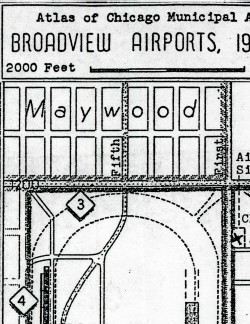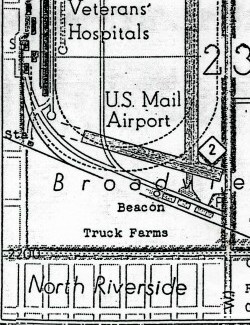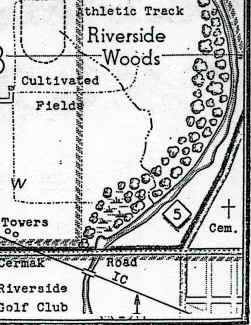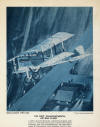



www.FranzosenbuschHeritageProject.org Home
Long before O'Hare, before Midway there was:
Checkerboard Air Field
Origin and History (1919-1929)
Prior to 1919, the only claim to fame that this plot of land had was serving as soil for Mr. John Schultz to till. The tract is located to the south and east of the intersection of Roosevelt Road and First Avenue.
During the spring of 1919, clothing merchants Decker & Cohen acquired this land and proceeded to construct an airfield. A metal hangar was erected on the northeast comer of this field, near the banks of the Des Plaines River. Meadows and pasture lands that were fairly level and free of holes made a suitable landing field for the airplanes of this era. Flying operations were possible on this field without having to prepare special runways.
The Birth of Checkerboard Field
Chief mechanic Louis Meyer, along with ex-Signal Corps pilots David Behncke and Bert Hassell, uncrated and assembled two planes the company had purchased. These airplanes, equipped with 90-HP Curtiss OX motors, were Curtiss JN-4 models, more commonly known as "Jennies". The Jennies carried a pilot and a passenger, fore and aft, in open cockpits, and enough gasoline for about two hours' flying time at a speed of sixty miles an hour. They were first put into action June 13, 1919, as Checkerboard Airfield opened for business and began sending the Jennies on delivery runs, bringing Society Brand Clothes to local towns within a 120-mile radius.
Back then, advertising was strikingly similar to what we see today, but on a slightly different scale and level. Ads back then were bright and colorful, just as they are today, but during the time that Checkerboard was operating, bright red and white checkerboard designs were found on the Jennies (to aid in the eye-catching advertisement of Society Brand Clothes) and on the roof of the hangar (to help pilots locate the airfield). Such bright patterns made it difficult to miss the planes passing overhead!
Obviously, the pilots did more than just deliver clothes in those Jennies. Off-hours were devoted to flying lessons, joy rides and pleasure hops. In addition, there was always stunt flying on weekends; such attractions brought people from miles around, creating a carnival atmosphere at the airfield.
In September of 1921 the spectators were entertained by Ethel Dare dropping from the clouds, and in 1922 Bessie Coleman entertained crowds at Checkerboard. Such excitement induced the spectators to buy raffle tickets for the chance to ride in one of the planes.




The Air Mail Connection
The first recorded instance of an Air Mail delivery was in January 1911 from Nassau Boulevard Flying Field in Garden City. New York. to Mineola, New York. The first organized air mail route was started on May 15, 1918 by the Post Office Department and the Army Air Force, and utilized Army pilots and airplanes flying between Washington D.C. and New York City with Philadelphia as a halfway stop. Initially, Curtiss Jennies with 150-HP Hisso motors were used on this route.
At the end of World War I, the Army converted a large number of DeHavilland Observation and Bombing Planes into mail planes for the proposed transcontinental air mail route.
In August of 1919. the Post Office Department took over the entire air mail operation, hired their own pilots, bought their own planes and started mail flights from New York City to Cleveland, Ohio, with Bellefonte, Pennsylvania as the halfway stop. On May 31, 1921, the route to Washington D.C. was discontinued. The Jennies were discontinued as well at that time and the DH-4 became the official air mail plane.
The official air mail plane had its problems; most significantly, the plane's engine endurance for the long transcontinental haul was troublesome Plus the structural modifications amounted to some 600 changes in the fuselage. The forward cockpit was taken out and moved further back, leaving space for the mail bag compartment, and the Liberty engine had to be overhauled.
These 400HP Liberty motors enabled the DH-4 to carry a cargo load of 400 pounds plus 100 gallons of gasoline at speeds up to 100 mph for as long as four hours.
Before the end of the summer of 1919, the route was extended from Cleveland to Chicago with Bryan, Ohio as a refueling stop. A strip of land in Grant Park, extending south along the lakefront from Randolph Street, was used as a landing field. A small hangar was erected at the north end of this field, about where the Amoco Building is today. Operations at Grant Park were limited by the size of the field, and prevailing lakefront winds made operations hazardous. Soon thereafter. Checkerboard was proposed as a new site due to its superior year-round flying conditions. In 1920 it was officially designated as Chicago's air mail field.
Early in 1920, a hangar was built on the west side of the field along First Avenue, several hundred feet south of Roosevelt Road. A small garage-type office was also built at the north end of the hangar, and in January the air mail operation officially moved to Checkerboard Field. Operations went well the rest of that winter, until a heavy April 1 snowfall followed by an early thaw softened the ground so badly that several landing aircraft nosed over in the mud and were severely damaged. Air mail operations immediately returned to Grant Park and remained there as cinder runways were put in at Checkerboard.
On May 15, 1920, Checkerboard resumed operations with its new runways and regular flights to and from Omaha, Nebraska began. By the end of the month, the air mail service was fully established at the increasingly well-known Checkerboard Air Mail Field. Later in 1920, Decker & Cohen clothing deliveries were discontinued, making Checkerboard exclusively an air mail field. Additions and modifications to the field included the setting up of a repair hangar, brought in from Bustleton Pennsylvania, just north of the original hangar that summer.
 The
first transcontinental flights were attempted on February 22,1921. Four
different airplanes participated in the grueling trip, two leaving from San
Francisco and two departing New York. The four simultaneous flights were
intended to prove to Congress that day-night transcontinental flights were a
possibility. Of the two New York-based flights, one was forced down shortly
after takeoff and the other landed at Checkerboard, only to be grounded by a
snowstorm. The first pilot from San Francisco crashed and died in Nevada but the
second made it to North Plane, Nebraska, where a relay pilot named James H.
("Jack") Knight took over. Knight left North Plane at 7:50PM and arrived at
Omaha, Nebraska at 1:15AM, where he found that his relief pilot had been snowed
in Chicago and had never made the flight to meet him at Omaha. Knight decided to
continue on himself and fly the 435 miles to Chicago despite the fact that the
Midwest was getting blasted by die fiercest snowstorm they'd seen in years.
Since the Des Moines refueling stop was also shut down due to the weather.
Knight was forced to an alternate site in Iowa City which had also closed down
once they had heard that the relay flight from Chicago had been canceled.
Fortunately, the Iowa City night watchman was able to guide Knight to a safe
landing just as the plane's fuel ran dry.
The
first transcontinental flights were attempted on February 22,1921. Four
different airplanes participated in the grueling trip, two leaving from San
Francisco and two departing New York. The four simultaneous flights were
intended to prove to Congress that day-night transcontinental flights were a
possibility. Of the two New York-based flights, one was forced down shortly
after takeoff and the other landed at Checkerboard, only to be grounded by a
snowstorm. The first pilot from San Francisco crashed and died in Nevada but the
second made it to North Plane, Nebraska, where a relay pilot named James H.
("Jack") Knight took over. Knight left North Plane at 7:50PM and arrived at
Omaha, Nebraska at 1:15AM, where he found that his relief pilot had been snowed
in Chicago and had never made the flight to meet him at Omaha. Knight decided to
continue on himself and fly the 435 miles to Chicago despite the fact that the
Midwest was getting blasted by die fiercest snowstorm they'd seen in years.
Since the Des Moines refueling stop was also shut down due to the weather.
Knight was forced to an alternate site in Iowa City which had also closed down
once they had heard that the relay flight from Chicago had been canceled.
Fortunately, the Iowa City night watchman was able to guide Knight to a safe
landing just as the plane's fuel ran dry.
While his plane was being refueled. Knight ate a donut and drank some coffee. He wasted no time and took off into the driving snow as soon as his plane was ready; he arrived at Checkerboard at 8:40AM, proving once and for all that day-night coast-to-coast service was indeed a feasibility.
In June of 1921, a large hangar was obtained from a former Army airfield at Key West, Florida, and was assembled south of the original Checkerboard hangar. Though this new building was intended to be used as a separate repair hangar, it soon became the only one when the original hangar burned down on Christmas Day. This wasn't all bad, as the newer structures were more substantial and larger than older ones. It was said that "...the mechanics really appreciated doors that closed tightly to keep out the cold winter wind. Later, all major repair and overhaul operations were moved to Checkerboard Field from New York, making it me maintenance center for the entire service. By this point in time, me air mail service had extended as far west as Omaha and Iowa City, with St. Louis and Minneapolis soon to follow.
Checkerboard Field operated from 1919 through 1923; after that it was occupied by Yackey aircraft. Checkerboard, now no longer an airmail center, continued as a private and commercial airstrip until 1924, when David Behncke sold the field to Wilfred A. Yackey. Checkerboard served as an overhauling center, where French Brequet bombers were converted to five-place civilian transport planes. Later, Yackey built and planned on starting production of a new plane of his own design; his progress on this endeavor though, ended on October 4,1927, when he crashed and died during a test flight of one of his new planes. The Government Civil Aviation Board declared Checkerboard unsafe for private and commercial use in 1927.
Let us backtrack a few years to 1918; the Government bought the land west of First Avenue, built Hines Hospital near 9th Avenue and turned the eastern portion of the land over to the Post Office Department, who in turn started building their own airmail field there and finished it in 1921. The January 1923 burning down of the Checkerboard repair hangar put the pressure on the Post Office Department to complete their own field on the west side of First Avenue, from Roosevelt Road south to the Illinois Central Railroad tracks just north of Cermak Road (22
nd Street). The brick and steel building, designated as the repair facility, was the closest one to First Avenue and the Railroad tracks and still has a face stone on its north elevation that reads "U.S. Air Mail". Two additional hangars were put up west of this main building along the tracks, and were used for service and operations.A 200-foot-wide L-shaped cinder runway was constructed, with the long leg running a length of 5500 feet along First Avenue; the short leg extended west-northwest toward the Hines hospital building, which was the only building on the grounds at the time. Army fliers at that time said. "...it was the best field in the country, and large enough to handle all the types of aircraft of that era." This field, which opened in May, 1922, was generally known as the Maywood Air Mail Field.
Airmail operations at Maywood Air Field were officially terminated on August 31 1927, when the Post Office Department contracted with privately owned airlines to carry the mail on a contract basis. At this point flying operations were moved to Chicago Municipal Airport, officially ending the story of Checkerboard Field. (See
Indifference Loses Maywood Aerial Mail, LaGrange Citizen, Mar 31 1927.)Contrary to popular belief, Charles Augustus "The Lone Eagle" Lindbergh did not fly from Checkerboard Field. Having been born in February 1902, he was only 17 years old when Checkerboard opened in 1919. In 1920, the Post Office Department chose Checkerboard as the best year-round airfield in the Chicago area, making him only 18 years old and a Minnesota farmer.
Lindbergh learned to fly in 1922 at the age of 20, and barnstormed in the West for two years, ending in 1925. He joined the Air Service Reserve in March of 1924 and graduated from the Army Air Service flight training program at Brooks and Kelly fields in 1925. Later that same year he joined Robertson Aircraft Corporation, and became chief pilot in flight instruction and passenger flights. He first flew the mail on April 15, 1926 between Chicago and St. Louis, by way of Peoria and Springfield.
Lindbergh successfully bailed out of his aircraft on four separate occasions:
On May 20, 1927 he left Roosevelt Field, New York, and arrived in Paris, France a little more then 33 hours later.
The Haunted Airport, By Paul Harvey Comment
"West of Chicago, east of Hines Hospital and south of the cemetery they lock the gates of Miller Meadow at night. It's a public place, part of the Forest Preserve District, but the gates are closed with heavy chains when darkness falls. I don't know whether the chains are to keep people out or to keep the ghosts in. If you were there you'd turn off a busy highway into a grove of trees, picnic tables and neat receptacles for refuse. Warm weekends, these acres of forest preserve just a half-hour west of Chicago's mid-city towers are overpopulated with ballplayers, barbecue broiling and picnickers. You keep going beyond the trees, there spreads out before you the expanse of Miller Meadow. A sign says, "Checkerboard Field" reserved for model airplanes.
"I discovered Checkerboard Field and this fascinating sport hobby simultaneously. Then.....I discovered me ghosts, the neglected history of this haunted airport is thrilling to an old birdman. From 1918 to 1927 this strip of cinders and sod was "the airport" for Chicago. An obscure German corporal named Hitler was writing a book called "Mein Kampf". Every car was the same model and color; Ford, Model-T, black. And in and out of Checkerboard field flew the Jennies, Standards and Brequets of that vintage. A Jenny cruised at 70 miles per hour and landed at 45 The pilots' heads sticking up in the wind wore helmets, goggles, scarves and cigars. You lit those cigars on takeoff, pulled up through the overcast, and when the cigar burned your lips it was time to let down. A six-and-a-half-inch cigar got you to Peoria.
"One day an old red DH circled two hours in the fog before landing at Checkerboard Field. The pilot, an skinny Swede from Minnesota named Slim Lmdbergh, had been hired to fly the mail between Chicago and St. Louis. Barnstormer Dave Behncke borrowed money and bought the pasture in 1921. He gave rides and lessons, and carried freight. His Jenny, black and white when it wasn't splotched with squashed grasshoppers was the "Checkerboard" from which the field got its name. Behncke lived to become founder and first President of the Airline Pilots' Association. His ghost is said to hover around the old airmail sack shack, which still stands today.
"The first ever airmail night flight landed on the Checkerboard. The pilot's name was Jack Knight. It was such bad weather all the way from Cheyenne that people along the route built bonfires to guide him. With ice piling up and the windshield a crystal spiderweb. Jack, with the airborne mail, landed his old tail-dragger at Checkerboard Field. His ghost still does. And in the days when a gas gauge was a wire sticking up from a piece of floating cork a gutsy J-3 jockey named Yackey folded a wing at 2,000 feet over Checkerboard. He'll haunt Miller Meadow forever.
"No point re-relating the escalating evolution which propelled airmen from 70 miles an hour to 700 miles an hour in one lifetime. No point in comparing the swashbucklers with today's supermen ATR captains. But it's worth remembering that "the friendly skies" weren't always so. And at Checkerboard Field these days, with the noisy modelers exploring a sophisticated new dimension in aviation, I'm willing to pack up at dusk - - let them secure the gates at night - - leave Checkerboard Field to the uncommon wingmen who first waded out into the uncharted ocean of air, then, looking back, waved for us to follow....", which we will.
The following marker still exists in the Forest Preserve park area along Roosevelt Road at the north in the that Preserve area.
Photo by Jim Arbuthnot
To review 1919 and 1920s news stories concerning Checkerboard see
The Maywood Herald.ACKNOWLEDGEMENTS
The Maywood Herald (articles).
The Chicago Tribune (articles).
Miller Modeler Newsletter. William Lombardi, Contributing Editor.
E. P. Benjamin, Maywood Historical Society, October 1955 (articles).
E. J. Pearson, President, Air Mail Pioneers, October 1955 (articles).
Albert and Josephine (Jo) Becker, Maywood Historians.
David Young and Neal Callahan. Fill the Heaven, with Commerce: Chicago Aviation 1855 - 1926
Howard L. Scamehor. Balloons to Jets: A Century of Aeronautics in Illinois, 1855-1955
Deepest thanks and appreciation to:
Robert M. Hill
William A. Cassin
William Lombardi
Ted Koston (Costopoulos)
Captain Charles S. Downey, USN Ret.
Christopher Lynch, Air Mail Historian
Robert Zawada, Historian/Archaeologist
Forest Park Public Library and Historical Society
Maywood Public Library
The Cross & Cockade Midwest Chapter
The Lind Family
Dear Friends
Much of this was prepared by Harold B. Lind, Maywood Historical Society, April 1997
Last Modified: 12/16/2006